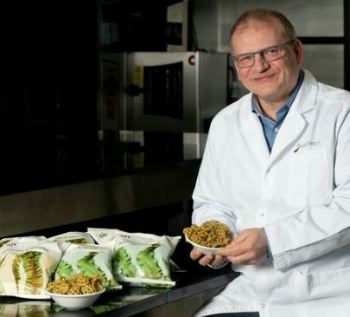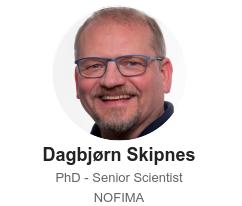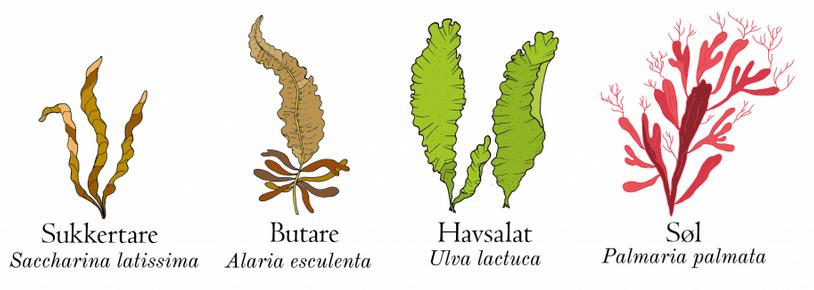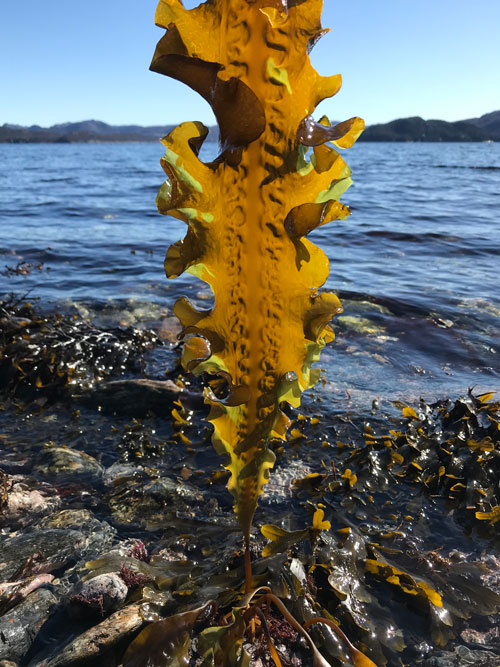|

Snack product of kelp from Sjy. Photo: Jan Inge Haga, Nofima
Green food from blue fields
 NORWAY
NORWAY
Tuesday, January 18, 2022, 07:00 (GMT + 9)
Kelp is beginning to play a key role in the Norwegian seafood industry. New start-ups are appearing on the scene, and researchers are involved in many projects. The industry has even estsablished a special interest group.
“Yes, this industry is environmentally friendly, green and organic, and will grow! Currently, there are around 20 kelp producers in Norway. We are going to see a lot more in just a few years time”, says kelp scientist Dagbjørn Skipnes.
Nofima’s senior scientist knows what he is talking about because has played a central role in the food research institute’s focus on kelp research since it was intensified six years ago. The growth is noticeable.
Interdisciplinary
Large and well-known food producers such as Orkla, Lofoten and Lerøy actively use kelp in their product development. And niche products are emerging. Nofima is working in an increasingly interdisciplinary manner in order to meet the knowledge requirements in the rapidly growing, new part of the Norwegian seafood industry. Today, for example, we can find kelp as:
- a snack flavouring
- a seafood flavouring
- a component in liver pâté
- a component in fish cakes
- a component in mackerel in tomato sauce
- a salt substitute in tomato ketchup
Some results
 “Nofima contributes knowledge throughout the entire value chain. When developing Sjy Seaweed’s kelp crisps, for example, scientists developed methods for the extrusion of the kelp, and we played a key role in developing the composition of the flavouring, in which kelp is an important ingredient”, says Dagbjørn Skipnes. “Nofima contributes knowledge throughout the entire value chain. When developing Sjy Seaweed’s kelp crisps, for example, scientists developed methods for the extrusion of the kelp, and we played a key role in developing the composition of the flavouring, in which kelp is an important ingredient”, says Dagbjørn Skipnes.
So far, Nofima’s kelp research findings can be summarised as follows:
- A few dozen research articles and reports on everything from cultivation, harvesting and pretreatment to processing, use in the food industry, marketing and consumer behaviour.
- New knowledge and tools for creating healthy products
- Recognition that production must be further developed:
- More efficient and with greater volume
- Less energy use on things such as blanching and drying
- Selecting the location and type of kelp for cultivation is crucial in terms of both growth and content
- Kelp that grows in nutrient-rich water is more resistant to pests
- Kelp that grows closer to the surface contains less iodine than kelp growing at greater depths
- Mechanical pressing, PEF and fermentation are all promising processing methods
- Enzymatic extraction of alginate and fucoidan can replace current processes
And not least: Several scientists who specialise in kelp have been recruited by Nofima.
“So far, we can count three bachelor’s degrees, four master’s students, an ongoing PhD and two postdoctoral fellows, and more are on the way. This gives the industries access to personnel who have a great deal of expertise in kelp”, says Dagbjørn Skipnes.
Basic knowledge
Nofima also plays a key role in the Norwegian Seaweed Association. This is an arena cluster, with core members, members and partners who, according to Skipnes, provide better coordination on not only the research, but the entire effort in the kelp industry.
“Previously, there were several small groups, but everyone is now gathered and works as a team in a different way than before. Therefore, the industry is developing at a rapid pace. And because several research institutions are on board, we also avoid researching the same thing in several places at the same time. The research communities cover different parts of the value chain and have different approaches and expertise so that the collaboration strengthens the results”, says Dagbjørn Skipnes.
The Institute of Marine Research, Møreforskning and Sintef Ocean were the first to start gathering knowledge regarding the modern production of kelp in Norway. Nofima and other stakeholders in the kelp industry have been able to benefit from this.
“The Institute of Marine Research and Sintef were able to provide us others with basic knowledge about developing the seedlings – the small algae growths that are used to start cultivation. But when it came to processing, they didn’t really know which way to attack, and this is when the experts at Nofima who specialise in process technology came into play”, Skipnes explains.
 and chef Stian Gjerstad Iversen with the new product_ They have been key contributors to the development of a snack product_ Photo_ Jan Inge Haga.jpg)
Senior scientist Dagbjørn Skipnes (left) and chef Stian Gjerstad Iversen with the new product. They have been key contributors to the development of a snack product containing 7.5% kelp. Photo: Jan Inge Haga @Nofima
One hundred percent organic
At Nofima, he and his colleagues are now working in a much more interdisciplinary manner, just like the rest of the institute sector. This involves economic aspects, market research and issues regarding growth, growing and ocean temperatures in different geographical areas of Norway.
According to the Nofima scientist, the market is also beginning to respond to the increased Norwegian kelp activity.
“In the past, there have been problems selling the crop. It has now become a seller’s market. Kelp has become part of Norwegian seafood”, Dagbjørn Skipnes states.
Seaweed and kelp are macroalgae and are one of the world’s largest renewable biomasses. They are found in huge quantities and many different species along the entire length of the Norwegian coast. According to the scientist, producing a food that is environmentally greener than kelp is a very hard thing to achieve. The fact that the environmental organisation Bellona is one of the owners of the production company Ocean Forest, says everything.
“Kelp cultivation is just about as green as gets. Photosynthesis takes place in the kelp. It binds CO2 and absorbs nitrogen and nitrates, so it has a purifying effect on the environment. It is a form of cultivation that does not require fertilizer or food. Cultivated kelp is one hundred percent organic and is also suitable for vegans”, says Dagbjørn Skipnes.

Kelp species you can eat (Nofima)
Rediscovery
Actually, the new interest in the brown and red algae which is so prevalent along the entire Norwegian coast is a rediscovery. Kelp has been used in livestock feed for as long as one can remember. Simply out of necessity when times were hard during the spring. And because free-roaming livestock visited the shoreline and ate kelp.
“Nofima is fully involved when it comes to processing and cultivation, but we want to take an even more interdisciplinary approach regarding the market and areas of application.”
For example, kelp may once again become feed for ruminants. They eat carbohydrates, so kelp is exactly what they should be eating. Adding kelp to silage feed reduces the large methane emissions produced by cows. Salmon are predators and are basically on the look out for proteins. However, this is an area where kelp may also have a use: By extracting the right components from kelp, it can also be used in salmon feed.
“And I get the impression that new areas of application are emerging wherever you turn”, the scientist says.
The iodine problem
 Kelp contains minerals, vitamins and fibre, which are all positive for humans. Iodine is one of them. Because people eat less fish, milk and salt that provide the necessary iodine supplement, kelp is a welcome addition to the diet. However, there are some challenges. Some types of kelp have a very high iodine content, and even small amounts of dried oarweed kelp can provide us with much more iodine than is safe to eat. Kelp contains minerals, vitamins and fibre, which are all positive for humans. Iodine is one of them. Because people eat less fish, milk and salt that provide the necessary iodine supplement, kelp is a welcome addition to the diet. However, there are some challenges. Some types of kelp have a very high iodine content, and even small amounts of dried oarweed kelp can provide us with much more iodine than is safe to eat.
<--- A great specimen of sugar kelp ready for harvest. Photo: Marthe Jordbrekk Blikra © Nofima
“The iodine problem is therefore taken very seriously among all producers of kelp. Those who ignore the problem won’t last long in the industry”, says Dagbjørn Skipnes.
Processing can solve the challenges regarding heavy metals and iodine.
“The industry has been aware for some time that blanching at a moderate temperature or boiling for a few minutes greatly reduces the iodine content. This is a solution that works for some products, for example when kelp is added to processed fish. Nevertheless, we are still conducting research on this in order find methods for extracting iodine and heavy metals without having to resort to boiling or other processes that result in high energy consumption, changes in quality and loss of nutrients. It involves both optimised blanching and completely new process methods. It is important to see the challenges, but also the bigger picture. If the kelp is processed correctly, the amount of iodine is not a problem”, the scientist states.
Nofima is continuing its kelp research with full vigour through several different projects that involve increasing interdisciplinarity.
“As Nofima food scientists, we are working to ensure that everyone has access to sustainable food. This is why we are also researching how to cultivate and process kelp so that it can be a safe and beneficial part of the range of food products on offer”, says Dagbjørn Skipnes
Source: Nofima
[email protected]
www.seafood.media
|



